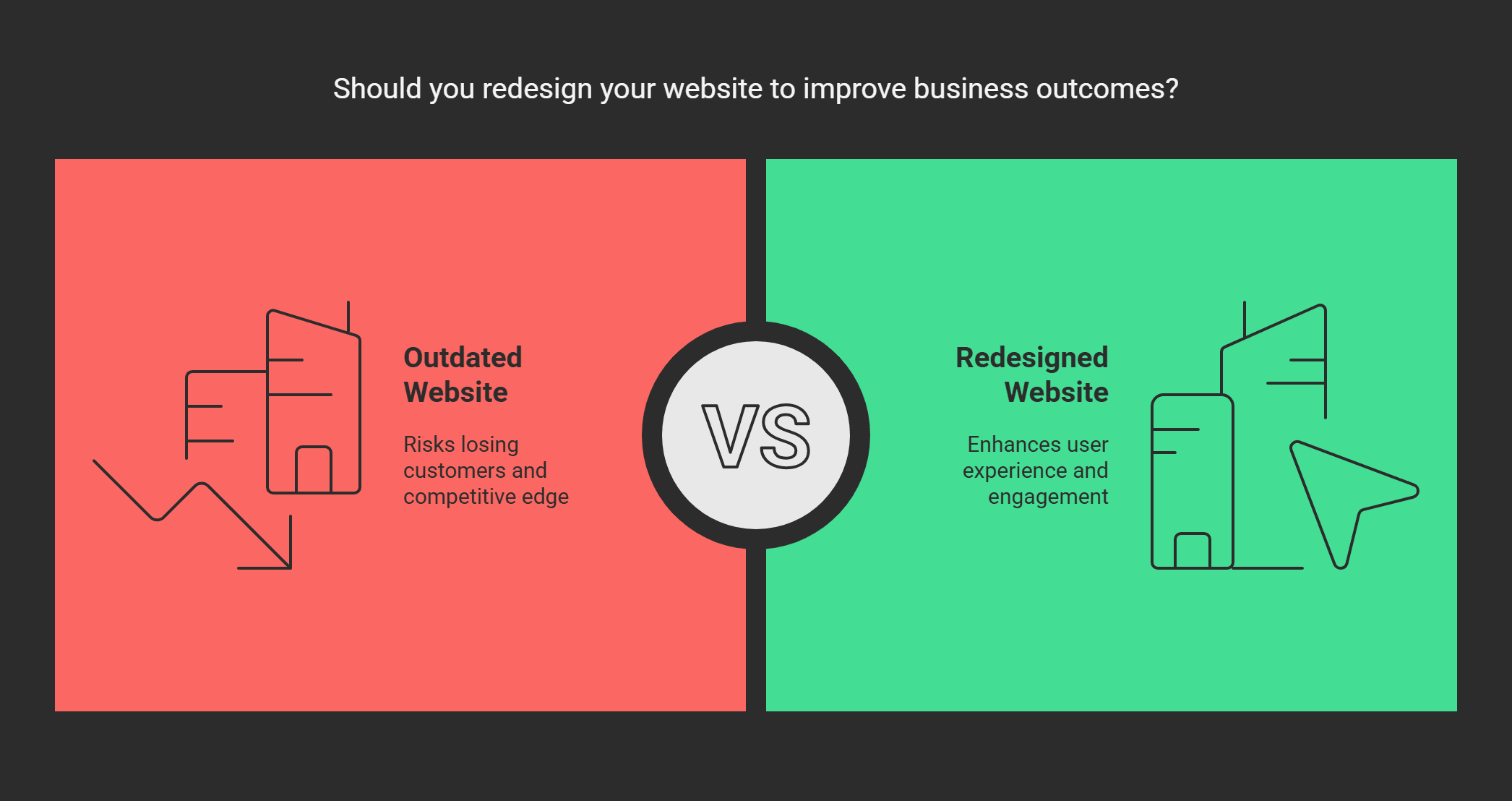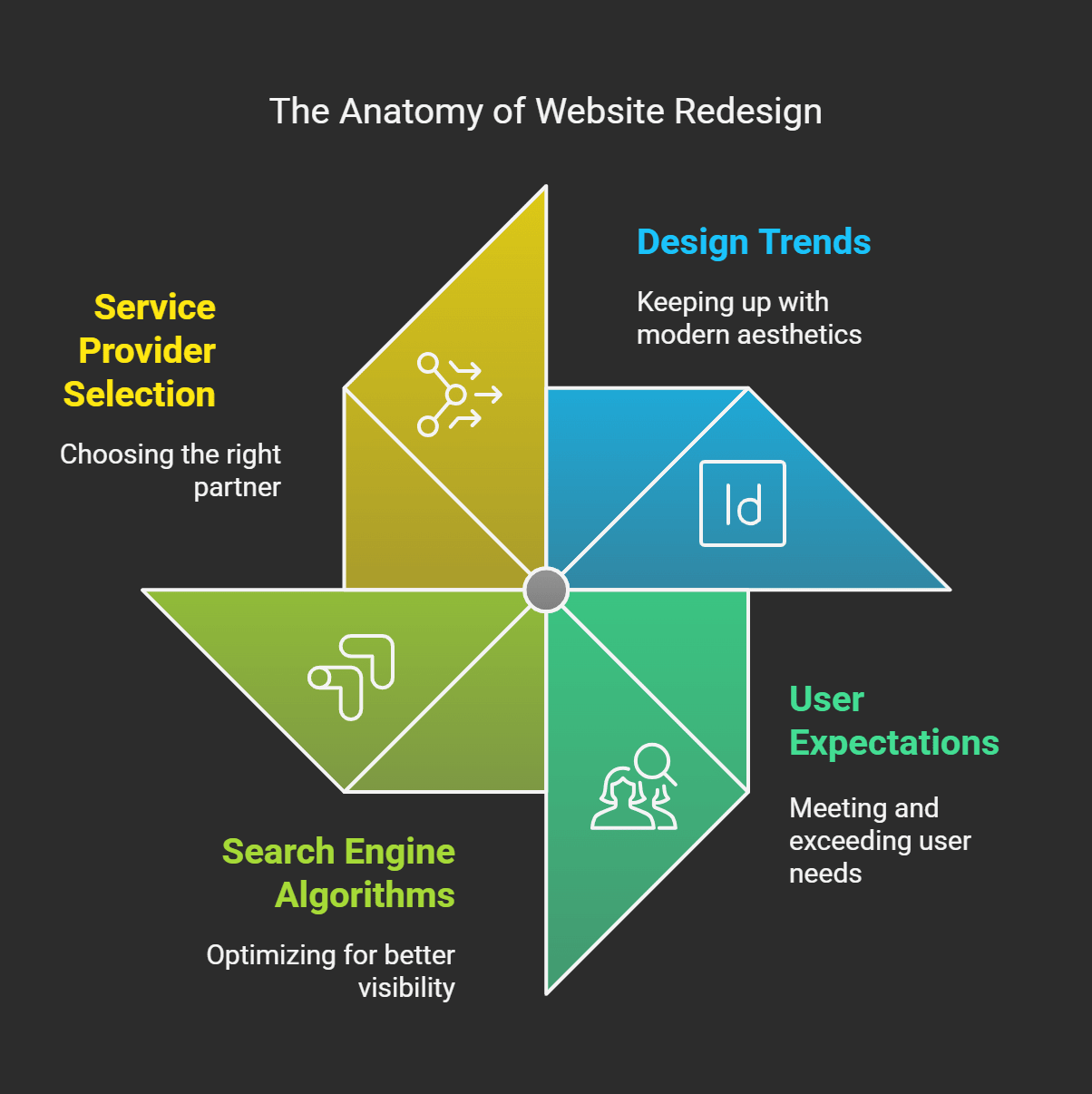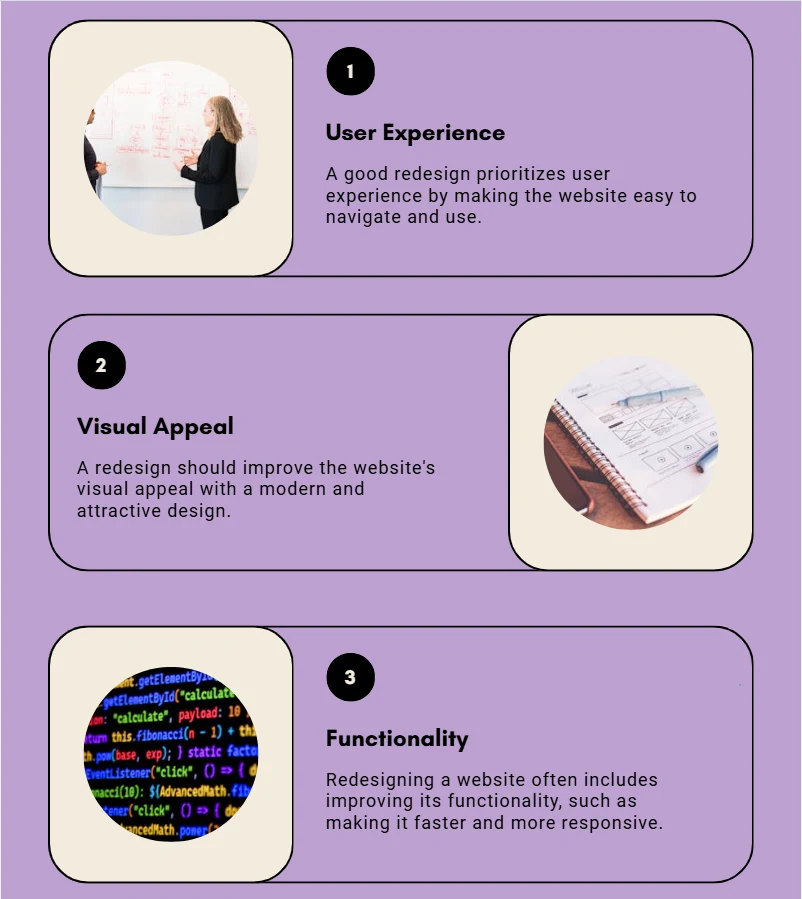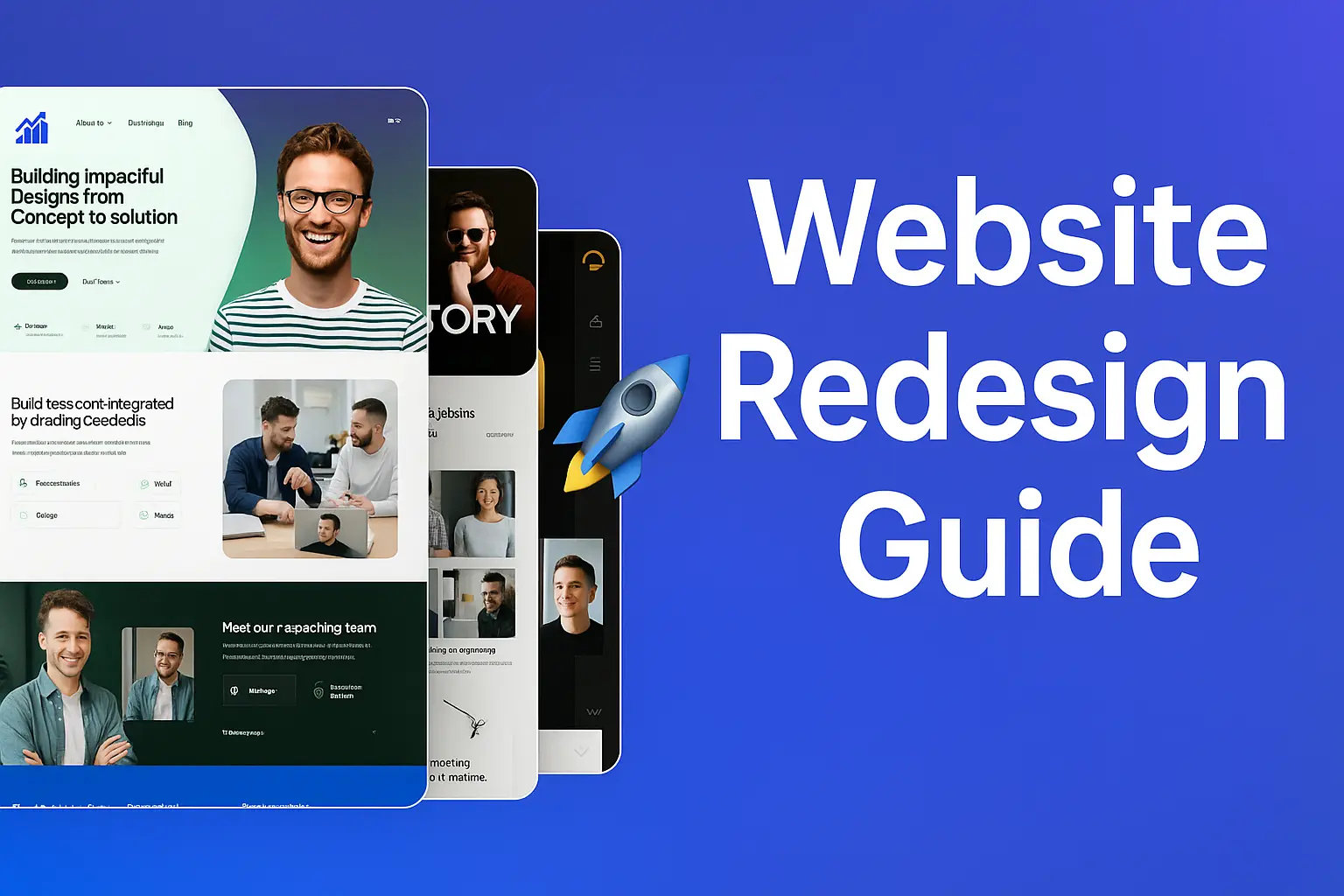
Did you know 94% of first impressions are design-related? In our digital-first world, an awful website is akin to offering your competition free leads. Whether your business website feels outdated or just isn't giving you the traffic you need, web page redesign services could be the move that changes the game for your business.
As 2025 rolls around, businesses must stay relevant regarding design trends, user expectations, and search engine algorithms. In this article, I'll cover everything you should know about website redesign services, from the whys to the how of service provider selection. So, let's get started and give your website the perfect glow-up it needs.
The Right Time to Invest in Redesign Services

Listen, I’ve seen a website or two in my time. Not so long ago, I ran this side business selling more homemade crafts online. My website? A total disaster. As a 90s GeoCities page regurgitated all over itself, Neon colors, Comic Sans font, and let’s say that the loading time reminded me that it was 1983. If I were a customer, I’d have left faster than you can say, “404 error.” That’s when I found out the hard way, your website is essentially your digital storefront. And if it’s not measuring up, you’re missing out on money in your pocket.
Fast forward a couple of years, and I finally took the plunge. I value it to meet my rate; however, I am an expert in redesigning my website. Man, what a difference. Traffic increased by 60% over three months; my sales? They doubled. But here’s the thing, it wasn’t simply about making it prettier although that was a perk. The magic truly happened in the background. Small things like adjusting load times, mobile optimization, and navigation tweaks were game-changers. So, believe me, getting website redesign services is not an extraneous gimmick but an actual game-changer.
Now, let’s get down to brass tacks. Cost is one of the biggest reasons people hesitate to redesign their sites. I know redesigns aren’t cheap. But consider this, research shows that almost half of users will abandon a site that takes longer than three seconds to load. If your site’s dragging its feet, you are handing over customers to your competition. And, of course, Google’s algorithm rewards fast, user-friendly sites. And yes, while spending money upfront might hurt, it will pay you back in the long run.
Here's a second thing I learned the hard way, first impressions matter a lot. Did you know that 75% of users determine a company's credibility based on its website design? Yeah, me neither until I saw my bounce rates soar. If your site looks ancient or just clunky, people click away fast. A clean, modern redesign not only helps you look professional, it builds trust. Trust translates into conversions. Simple as that.
Oh, and let's not forget SEO. This is where it gets juicy. When I published my new site, I observed this strange thing, my rankings picked up like I was on steroids. As it turned out, the redesign covered things I hadn't considered including proper meta tags, alt text for images, and clean code. These small changes might not make much difference in your traffic, but if you're searching you better believe it. What is the moral of the story? SEO shouldn't take a back seat during a redesign. It's the secret sauce.
One more tip before I leave you to it: don't DIY everything. Sure, some tools promise to help you refashion your site without employing anyone. But if you're not a tech whiz, you will probably miss vital information. Trust me, I tried to do it myself, and it ended in tears and a server crashed. Avoid the headache and hire professionals to take care of it. Find Involves has a track record, can show you examples, and listens to your goals.
Ultimately, investing in website redesign services isn't just about looks. It's about designing an experience that pulls people in. Whether you are opening a small blog or a full-fledged e-commerce empire, your website deserves to be on a pedestal. If cute little craft shops like mine can have a redemption arc with a redesign, what can it do for you?
Advantages of Hiring Professional Website Redesign Services

Let me tell you, I’ve been around the block when it comes to website redesigns. There was this one time years ago now that I thought I could do a DIY site refresh. Things didn't turn out well. My homepage was a glorified neon nightmare; half the buttons didn’t function. Things didn’t start clicking (literally) until I hired a professional. That experience also taught me the value of hiring the pros for something as important as a website redesign.
First, user experience or UX if you’re an acronym person. A pro knows how to make your site look good but feel intuitive. I once looked at a client’s old website with so many pop-ups and distracting menus that I was like, I’m out of here in two minutes. Because, honestly, who has time for that? Pros set a clear tone, ensuring visitors can find what they’re seeking without wanting to pull their hair out. They also optimize page layouts based on accurate data, not guesswork. For example, placing CTAs where users are most likely to see them can increase conversions by as much as 30%. Yeah, you heard me correct 30%.
And here’s a big one, SEO performance. When I started my blog, I did not know how much all that backend stuff matters. Meta tags? Alt texts? Schema markup? I didn’t know any of that jargon at the time. But man, I sure paid for that later. They cleaned all that up after I hired a redesign service for them and boom my traffic skyrocketed by 45 percent in just three months. Crazy, huh? The professionals aren’t just laying fresh paint on your site; they are digging deep into its bones and making sure everything is search engine optimized and is still easy to read for people.
Pros also excel at speed. If your site drags on forever, folks bounce quicker than you can say "404 error." I learned this the hard way when I saw my analytics showed a 60% drop-off rate and that my pages were crawling like a snail. It turns out that none of this was the case; the image compression and minified code did the majority of the heavy lifting. And it turns out that professionals have tools and tricks up their sleeves to help ensure "lightning" load times that Google loves nearly as much as we do.
And, of course, aesthetics can't be ignored. A polished appearance isn't only about looking nice it creates confidence. If you were a consumer, would you want to buy from a slick e-commerce store or some backwater hunk of junk from 2005? Exactly. One of my favorites was a redesign of a local bakery's site. We included hi-res images of their cakes and pastries in collectible format and an intuitive booking system for customized orders. Their sales exploded, and I felt proud, like a parent watching it happen.
Oh, and one little nugget of wisdom that some people don't think about: don't skimp on mobile optimization. Nowadays, more than 50% of web traffic is from phones. If your site looks wonky on a smartphone, you're losing customers right and left. Believe me, I've witnessed companies get crushed for not heeding this advice.
In short, getting professional website redesign services is worth the investment. Rich UX, killer SEO, faster speeds, stunning visuals like a full glow-up for your digital presence. And look, if you're anything like me, you'll rest easier knowing that the tech nerds are doing the heavy lifting.
Signs That You Require a Website Redesign

Okay, then, let's jump right into it. Sitting at my computer with my website open, I've been there, asking myself if it was time for a redesign. But how do you know? Allow me to take you through a few obvious signs I've learned over the years and a few embarrassing missteps the gift that keeps giving.
First, slow speeds kill your site. If your website takes longer than 3 seconds to load, you lose people before you can utter "conversion rate." I once had a client who insisted their site was in perfect working order until we ran a performance test. Surprisingly their homepage was dragging 5 MB+ images around. Yeah, it's no surprise users didn't stick around. So here's the deal, test your page speed with Google PageSpeed Insights or GTmetrix. Anything below 70? It's a red flag.
Now, let's address bounce rates. If your number is sky-high, it's not bad luck, it indicates something's wrong. A couple of years ago, I redesigned a local bakery's site because it had a bounce rate off the charts. The problem? Their menu was hidden under five submenus, and half of the links were broken. Folks were fed up, and they departed. That being said, navigation needs to be stupid and simple. It's time for a redesign if visitors can't find what they need in three clicks or less.
Mobile optimization, or lack thereof. Remember when everybody said the desktop was king? Those days are long gone. That's right, over 60% of all web traffic comes from mobile devices. Once I ignored this stat, I got hurt for it. It was late 2023, and my analytics data revealed a steep decline in mobile users' engagement. When I finally bit the bullet and went responsive, traffic increased by 40% overnight.
The takeaway: Test your site on as many devices as possible. You have work to do if it appears on a phone in wonky form.
And then there's aesthetics. Is your site stuck in 2010? You know the kind with lots of scrolling banners, Comic Sans, stock photos of people laughing while eating salad. Trends change, folks. It's all about clean lines, bold typography, and dark mode options in 2025. Don't believe me? Ask your customers. Feedback matters.
Finally, scrutinize your metrics. Are traffic numbers dropping? Conversions plateauing? These aren't just random blips, they're cries for help. One trick that I have is comparing my site to competitors' sites. If it looks fresh and modern and mine feels like antiquity, sure, it's time to plan an upgrade.
Things to Consider When Choosing a Website Redesign Service Provider

Listen, I've been burned before, let me tell you something. Several years ago, I employed what I considered to be the perfect website redesign service provider. They had this slick portfolio and glowing testimonials; they could offer me a discount if I signed up in the next 24 hours. It did not end well. It compromised a lot, and the site they delivered, while looking great on the outside, was a complete mess on the inside.
Broken links all over the place, no mobile optimization (hey, 2015 called they want their clunky designs back), and don't even get me started on how terrible the SEO was. Fixing everything took months and involved another agency. Needless to say, I learned my lesson the hard way. And now, I'm here to save you from the same fate.
Let's not beat around the bush, experience counts. So, don't be swayed by flashy portfolios or bargain-basement prices when trying to find someone to redesign your website. Dig deeper. Ask them for similar projects they have done. Did they have experience with e-commerce sites? Blogs? Corporate pages?
If you're a local baker, a tech startup guy isn't the right hire for you. Believe me, lack of expertise matters a lot. One time, a designer told me they "did it all," but later, I realized they hadn't ever touched WooCommerce, a disaster, considering half of my client's sales were through their online store.
Communication is another one of the biggies. Do you know those agencies that disappear after the first meeting? Run. Far away. A good provider will share updates with you throughout the process. Weekly check-ins, progress reports, and clear deadlines are non-negotiables. I had a project where the team went missing for three weeks. No emails, no calls.
By the time they resurfaced, the timeline had reset entirely, and we had missed our launch date. Not fun. Be direct, What is their preferred form of communication? Slack? Email? Carrier pigeon? Only kidding on that last one, but clear language is a headache-saver.
Now, let's move on to technical chops. Sure, it must look good, but it must also work like a dream. It also includes clean code, fast loading speeds, and bulletproof security. Oh, and did I mention SEO? Yeah, that's huge. Many redesign services get so focused on beauty that they forget about search. Big oops. Just ensure whoever you employ knows their meta tags from their alt texts. Extra points if they provide post-launch assistance as well. Websites aren't a set-it-and-forget-it; they require regular updates and maintenance.
Here's a pro tip: Request references. Real ones. Not just randomly selected names out of the blue. Ongoing touch and invite previous customers to ask about their experience. Were there hidden fees? Was the project on schedule? Would they refer the provider to other people? These chats can help you avoid signing with a shady figure.
Lastly, trust your gut. If something feels wrong in the consultation if they're overselling you, underselling you, or acting clueless about your industry it's probably a red flag. Remember that this isn't just about obtaining a shiny new site. It's about discovering a partner who understands your vision and gives you the tools to make it happen.
All the Stages of Website Redesign Process: A Step-by-Step Guide

I’ll be the first to tell you that I have walked the website redesign gauntlet more times than I can count. Some were smooth sailing; what about the others? Let me put it this way, they felt like trying to patch up a hole in a leaky boat while still at sea. But hey, that’s what you learn, right? So today, I will guide you through my tried-and-true process for successfully pulling off a website redesign with no life jackets necessary.
Begin With a Heart to Heart (Consultation & Goal Setting)
Before I even touch code or design tools, I talk honestly about goals. No, seriously this section is critical. Once, I didn’t do it because I figured I “knew what the client wanted.” I didn’t. We had to redo half the work later anyway.
So how does this work? Consider asking questions like “What’s not working on your current site? or “Who is this actually for?” Perhaps they want to increase sales, enhance user experience, or make it easier for users to find information. Document these goals and they'll guide every decision from here on out. And be sure to check the analytics. Numbers don’t lie, folks.
Pro Tip: Involve stakeholders from Day 1. Trust me, nothing is more disastrous than showing someone a near-finished product and hearing them say, “This is not what I had in mind.”
Dig Deep (How Well Do You Know Your Current Site?)
Let’s get into the nitty-gritty of auditing your existing website. Consider this spring cleaning for your digital space. You’ll be searching for weak spots, slow load times, broken links, and stale content.
In one audit, I found that over 40% of the users were dropping off because the checkout page took ages to load. After we resolved that, conversions soared by 25%. What is the moral of the story? Data matters. Use tools like Google Analytics, SEMrush, or Screaming Frog to get insights into performance metrics.
Oh, and don’t slouch when it comes to SEO, either. You will kick yourself later if you lose those rankings during the redesign. Check that URLs, meta tags, and alt texts are all in order.
Make A Rough Sketch (Wireframing & Prototyping)
And now comes the fun bit designing. But hold your horses. Instead of going straight to Photoshop or Figma, start with the wireframes. Essentially, these are your site’s blueprints. They keep everyone focused on the layout without becoming distracted by colors or fonts.
It was once a huge mistake for me to skip wireframes altogether. The developers mistook the design brief, and we spent weeks back and forth. Masterclass learned, prototype first. This is incredibly easy and affordably provided by tools like Adobe XD or Balsamiq. Get them out to your team and solicit early feedback.
Side note: Keep it simple; don’t complicate it. Users do not need unnecessary flashy animations everywhere.
Development Phase: The Initial Approach Fit It Right
When the designs are set, it’s time to animate me. This stage can be daunting, especially when dealing with multiple developers or freelancers. Communication is key here. Set deadlines, be clear on who’s doing what, and monitor progress through project management tools like Trello or Asana.
One tip I swear by? Test everything as you go. Broken buttons, wonky layouts, missing images you catch ‘em now, not post-launch. And believe me, fixes after launch are much more difficult.
Check Other Devices: Testing on Different Devices
Test, test, and test before you hit publish. Check your site on various devices phones, tablets, laptops and browsers as well. Chrome might be fine, and Safari could be a hot mess.
A few years back, I set up a site without adequate testing. Unfortunately, the mobile menu didn’t function at all, which caused panic mode. It was a good thing we discovered it quickly, but it taught me never to take shortcuts in QA.
Launch Like a Pro (Go Live)
And now, the moment of truth, launching your shiny new site. But it’s not time to hit “publish” and then take a break. Closely monitor traffic during the first few days. Are there any weird errors? Are you sure everything is loading correctly?
And don’t forget, redesign doesn’t end at launch. Continue refining based on usage and data. After all, websites aren’t constantly changing, but so do businesses.
There you have it, a solid roadmap for a website redesign. Yes, it takes work, but when done correctly, it pays dividends. Now go and give your site the glow-up it deserves.
Website Redesign: Common Mistakes to Avoid

I've been through more website redesigns than I care to admit. Some were awesome like that one where we got recs traffic up 300% in 3 months. Others? Let's say they were learning experiences. And believe me, there are so many significant pitfalls you don't want to fall into when redesigning a website. Here's what I've learned through trial and error.
To begin with, the nothingness of SEO during the redesign process is like throwing your Google rankings into the fire. Yeah, I did this once. We had weeks to practice the design and ensure all the visuals were crisp and contemporary ridiculous, right? We lost half our visitors because we had forgotten to redirect (properly) old URLs. Our organic traffic plummeted into the ground faster than my confidence then. You need to know that always create 301 redirects for all changed URLs. It may not be exciting, but it works well for search engines.
Using unnecessary features or animations creates a load on your site. Yes, it looked cool on the surface, but users hated it. They didn't know how to navigate without getting distracted by all the moving pieces. Could you keep it simple, folks? Stylistically, a clean, intuitive design will always trump flashy gimmicks.
Oh, and don’t get me started on not testing to ensure things work across devices and browsers before hitting publish. This one launch all worked well on Chrome until someone opened the site on Safari, and half the buttons didn’t work. Embarrassing is a none-too-strong way to put it. Always test on multiple browsers (Firefox, Edge, Safari) and devices (desktops, tablets, phones). If you have to, use things like BrowserStack it’s worth every cent.
A common mistake I witness constantly is the failure to engage stakeholders early enough. On one project, we got so deep into the redesign and a series of revisions that we realized halfway that the client hated the work. Talk about a facepalm moment. Solicit early and frequent feedback from key players. Getting feedback from your boss, teammates, or customers can spare you from costly adjustments.
Finally, forgetting about post-launch is an amateur move. You may think you’re done once you hit “publish,” but you are not. A website requires care and attention in the years following launch. Monitor performance metrics, fix broken links, and adapt to user behavior flexibly. My favorite tool for this is Hotjar it creates heatmaps and clicks patterns so you can see where users are getting stuck.
So there you have it some of the most significant mistakes I’ve made (and seen others make) when redesigning a website. Avoid these mistakes, and you’ll be light-years ahead of your competition. Now get out there and redesign like nobody’s business.
Key Trends to Adopt in Website Redesign Services in 2025

Let me tell you, I’ve been around the block when it comes to redesigning websites. When I started, OK, not long ago, I worked on a project that attempted to “modernize” a site by throwing some stock photos and a cool slider down. Things went south super fast, and, to be honest, I still cringe. Fast forward to today, and nothing is more dynamic than that change. So, if you’re looking forward to a website redesign soon, hold on tight because 2025 has some crazy (but significant) trends in store.
First up, AI-powered personalization. You know those annoying pop-ups that say, “Hi, [Name]!”? But they don’t serve any purpose? Yeah, those days are over. Now, AI tools can analyze user behavior and present customized content based on what users most likely want to engage with. One great example is how I helped a client implement an AI recommendation engine on their e-commerce platform. In less than three months, sales increased by 27%. If your redesign doesn’t involve personalization, you miss out on opportunities.
Oh, and here’s another that’s exploding, dark mode. People love or hate it, but either way, it’s here to stay. A couple of years ago, I redesigned a blog for a tech startup type of company, and they wanted to implement a light and dark mode toggle. At first, I thought it was overkill, but guess what? They saw a 15% increase in user retention as a result. Go figure. Dark mode isn’t just a fad; it lowers eye strain, meaning visitors will stick around longer.
Another one is voice search optimization. You’ve probably seen more people asking Siri or Alexa questions rather than typing them. Websites, well, they have some catching up to do. In a recent redesign for a local business, we optimized their FAQ section for voice queries. Long-tail keywords like “Where to find vegan pizza near me?” became gold mines for traffic. What is the moral of the story? Think conversational.
Here’s one I’m excited about sustainability in web design. Want to know one of the significant sources of global carbon emissions? That’s nuts. So, in 2025, we expect to see eco-friendly hosting solutions and lightweight designs. This past year, I partnered with a nonprofit to help decrease their site’s energy use by minimizing animations and compressing images. They did not just save some cash on hosting fees but received loads of appreciation from the donors who loved their green initiative.
There’s also interactivity. Static sites are so 2015. Today, users want dynamic elements, including hover effects, clickable infographics, and micro-interactions. The one time I did this, I also put a little animation for the buttons where they would gently pulse when hovered over. It may seem incremental, but conversions shot up 8%. Small gestures and tokens are the loftiest of thoughts.
Of course, minimalism still reigns supreme. Clean visuals, abundant in whitespace, and straightforward navigation aren't going anywhere. But don't confuse minimalism with insipid blandness. The balance between simple and personality. For this one project, I installed a bakery. They needed a clean design but retained their wacky illustrations.
So, whether you're getting into AI, adopting dark mode, or getting green, here's the key: Trends may change, but good UX is always in fashion. As clarity reigns supreme, most of the time, keeping your audience at the top of your mind, you will hit your redesign marks with success.
In Closing
Your website is where many people first encounter your business and potential customers, so work to make it at home. Using the best website redesign services, you can give a new direction to your online presence, increase user contentment, and boost your conversions. Now, don't let that outdated site drag you down in 2025.
Ready to take the next step? Contact a trustworthy website redesign professional today and begin transforming your digital footprint. Your website isn't just a tool; it's your brand's online home. Make it shine.




.svg)
.svg)
.svg)
.svg)












